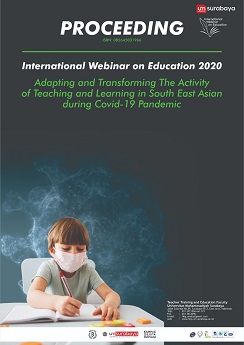Analysis of students CRI (Certainty of Response Index) of genetic concept based two-tier diagnostic test online using I spring suite 8 for covid-19 learning
Abstrak
Abstract.
Technology-based learning in the covid-19 pandemic period faced many
obstacles and challenges. Consequently, the learning design and strategy are expected to be effective, efficient and able to empower student competencies appropriately. One of the important points in learning during the Covid-19 epidemic was an effective learning evaluation. One of the effective learning evaluation in pandemic period is the online multiple-choice test. However, multiple-choice tests in the form of online quizzes also have some short ages, for example, it is quite difficult to capture the student‘s mastery concepts evel in more depth and detail. Therefore an online multiple choice test evaluation form can be developed with a two-tier system, so that it can showed the level of students understanding and thinking further. Moreover, the certainty of response index also added to determine the level of student confidence in the answers given. The purpose of this study was to analyze the student‘s understanding with the Certainty of Response Index (CRI) on genetic material using two-tier online diagnostic test based on the I spring suite 8application. The method used is descriptive. The subjects were all 2018A IKIP Budi Utomo Malang students, with the total number of 18 students. The results showed that the CRI level of students tends to be low, the answers and reasons are not correct and related each other, so it seems that the students are answer randomly which unable to show logical reasons related to answers. Some factors that causing the low level of student understanding and CRI are the characteristics of genetic material that‘s abstract and difficult, the scope of the material are complex and complicated, the initial ability of students, and the use of learning resources that are not optimal.
Referensi
S. Yezli and A. Khan, ―COVID-19 social distancing in the Kingdom of Saudi Arabia: Bold measures in the face of political, economic, social and religious challenges,‖ Travel Med. Infect. Dis., no. March, p. 101692, 2020.
Y. Liu et al., ―What are the underlying transmission patterns of COVID-19 outbreak? An age-specific social contact characterization,‖ EClinicalMedicine, vol. 22, p. 100354, 2020.
M. S. Weaver and L. Wiener, ―Applying palliative care principles to communicate With children about COVID-19,‖ J. Pain Symptom Manage., 2020.
F. R. Putra, ―Review model pembelajaran problem solving,‖ pp. 1–3, 2020.
N. Ikhwan, ―Penggunaan software dalam Pembelajaran kampus di masa pandemi COVID 19,‖ 2020.
N. R. Kusuma, M. K. Mustami, and O. Jumadi, ―Pengembangan media pembelajaran interaktif power point Ispring suite 8 pada konsep sistem ekskresi di sekolah menengah atas,‖ vol. 13, 2018.
A. S. Pritakinanthi, Kurikulum dan teknologi pendidikan fakultas ilmu pendidikan Universitas Negeri Semarang 2017. 2017.
N. Kurniasih and N. B. Haka, ―Penggunaan tes diagnostik two-tier multiple choice untuk menganalisis miskonsepsi Siswa kelas X pada materi Archaebacteria dan Eubacteria,‖ Biosf. J. Tadris Biol., vol. 8, no. 1, pp. 114–127, 2017.
C. Tüysüz, ―Development of two-tier diagnostic instrument and assess students‘ understanding in chemistry,‖ Sci. Res. Essays, vol. 4, no. 6, pp. 626–631, 2009.
Nahadi, W. Siswaningsih, and R. Purnamasari, ―Pengembangan tes diagnostik two-tier dan manfaatnya dalam mengukur konsepsi kimia siswa SMA,‖ J. Pendidik. Kim., vol. 1, no. 1, pp. 51–58, 2014.
S. Ulfah and H. Fitriyani, ―Certainty of Response Index(CRI): miskonsepsi siswa SMP pada materi pecahan,‖ in Seminar Nasional Pendidikan, Sains dan Teknologi, 2005, pp. 341–349.
E. M. Waluyo, A. Muchyidin, and H. Kusmanto, ―Analysis of Students misconception in
completing mathematical questions using Certainty of Response Index (CRI),‖ Tadris J. Kegur. dan Ilmu Tarb., vol. 4, no. 1, pp. 27–39, 2019.
W. Liliawati and T. R. Ramalis, ―Identifikasi miskonsepsi materi IPBA di SMA dengan menggunakan CRI (Certainly of Respons Index) dalam upaya perbaikan urutan Pemberian materi IPBA pada KTSP,‖ in Prosiding Seminar Nasional Penelitian, Pendidikan, dan Penerapan MIPA, 2009, pp. 159–168.
D. Hasan, S., D. Bagayoko, and E. L. Kelley, ―Misconseptions and the Certainty of Response Index CRI),‖ 1999.
P. Suparno, Misconception and concept change In physics education. Jakarta: PT. Gramedia Widiasarana, 2013.






